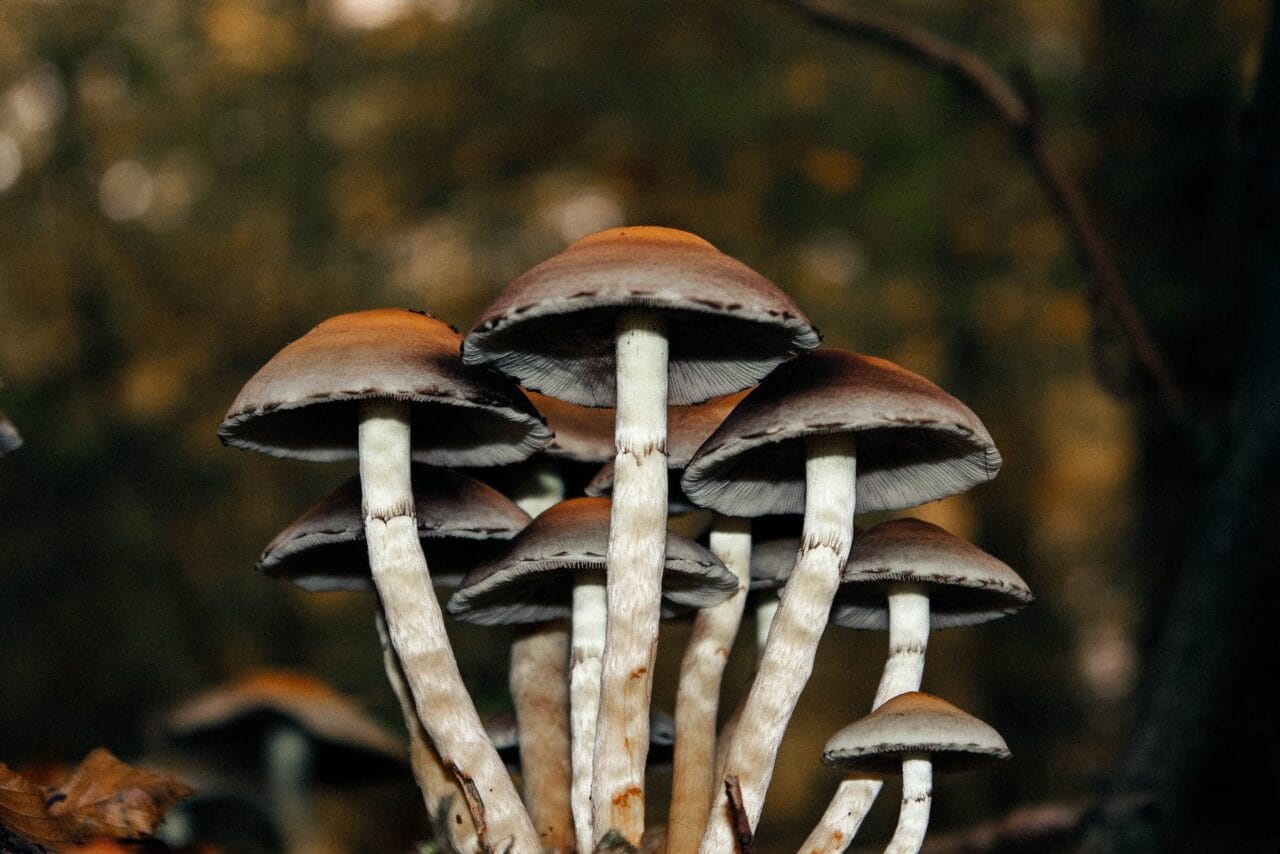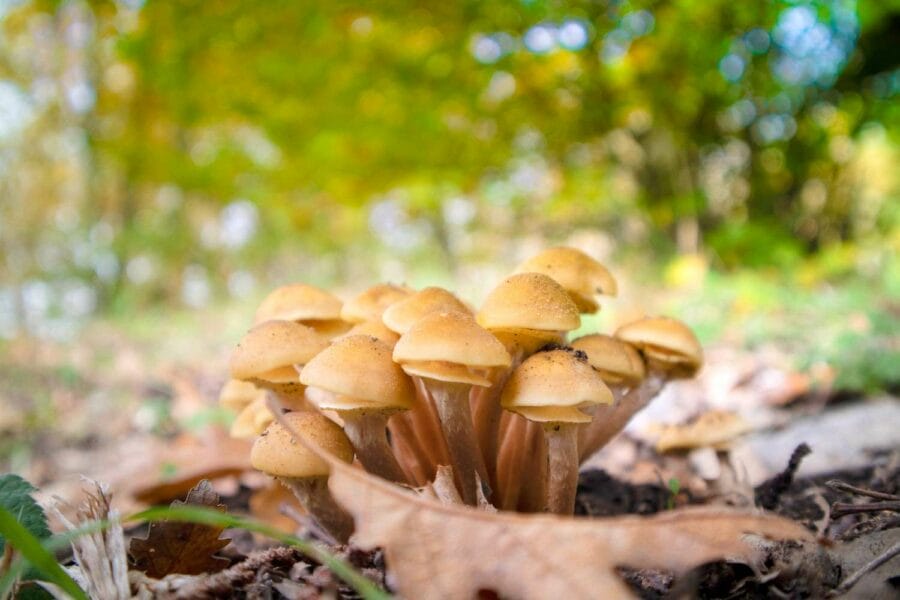Psilocybin, a psychoactive compound present in magic mushrooms, is frequently used recreationally for inducing hallucinations and euphoria.
Beyond its mind-altering properties, research has also been conducted on the compound’s potential benefits for providing relief from chronic pain.
This piece presents a case study that investigates the potential use of microdosing mushrooms for chronic pain relief.
Key Takeaways:
- Microdosing mushrooms could potentially provide both immediate and sustained pain relief.
- Psilocybin microdosing, compared to traditional pain medications, typically has fewer side effects when taken in small doses.
- Among other benefits, psilocybin interacts with the serotonin 2A (5-HT2A) receptors to alleviate pain.

The Study
The research titled “Microdosing Psilocybin for Chronic Pain: A Case Series” was carried out by Dr. Matthew Lyes and his team from the Division of Pain Medicine in the Department of Anesthesiology at the University of California, San Diego. The study centered on three patients who used small doses of psilocybin to control their chronic pain symptoms.
Three Patients, One Result – Reduction of Chronic Pain
Patient # 1
| AGE/ GENDER: | 37, Male |
| PAIN TYPE: | Neuropathic pain occurring below the site of a spinal cord injury. |
| PAIN INTENSITY: | Initially 4 to 5/10, increasing to 8/10 later in the day |
| PSILOCYBIN DOSE: | 250 mg of ground mushroom for under 6 months |
| OUTCOME: | Discontinuation of prescribed pain medication, decrease in muscle spasms, and improved bowel movement efficiency. No signs of rebound pain or withdrawal symptoms. |
| The patient reported that while his usual medications merely reduced the pain, psilocybin effectively eliminated it, lowering his average pain level from 5 to 0. | |
Patient Case Study: #2
| AGE/GENDER: | 69-year-old female |
| PAIN TYPE: | Complex Regional Pain Syndrome (CRPS) |
| PAIN INTENSITY: | Typically rates between 5 and 7 on a scale of 10, with increased intensity during physical activity and pain flare-ups |
| DOSAGE OF PSILOCYBIN: | 500 mg daily for 7 to 10 days with 2 to 3 day rest periods over a year. Dosage increases to 750 mg to 1 gram during pain flare-ups |
| OUTCOME: | 80% reduction in pain for 3-4 hours, with the pain gradually returning to original levels after 12 hours. Complete pain relief (90%-100%) lasts for 6-8 hours, returning to initial levels after 18 hours. |
| The patient reported a reduction in appetite without any associated nausea. A sense of disorientation or instability while walking was observed when the dosage was increased (750 to 1000mg). | |
Patient Case Study: #3
| AGE/GENDER: | 40-year-old female |
| PAIN TYPE: | Lumbar radiculopathy and neuropathic pain |
| PAIN INTENSITY: | 8 on a scale of 10, rising to 10 during physical activity |
| DOSAGE OF PSILOCYBIN: | 1000 mg from a mushroom chocolate bar every two months. |
| OUTCOME: | Significant pain relief without experiencing any psychoactive effects. Noted improvements in flexibility and functionality. The pain slowly returns to original levels over a span of 2-4 weeks. Repeated dosing enhances pain management. |
| The patient did not experience any significant physical, cognitive, or behavioural side effects. Her mood remained stable throughout the treatment. She continued her regular SSRI dosage for managing depression during the psilocybin treatment period. | |
Decoding Pain Management through Psilocybin
Constant somatic and visceral pain signals can strengthen certain neural pathways due to peripheral and central sensitization, resulting in a chronic experience of pain, both physically and emotionally. Psychedelics like psilocybin activate 5-HT2A receptors, potentially resetting brain areas associated with neuropathic conditions.
One patient reported enduring pain relief for several weeks. This suggests that direct stimulation of the 5-HT2A receptors could lead to central regulation of pain perception and
Adaptability of synapses.
Potential Side Effects of Psilocybin vs. Traditional Pain Relievers
| PSILOCYBIN (Based on Studies) | TRADITIONAL PAIN RELIEVERS |
| Muscle spasms | Nausea |
| Diminished appetite | Gastrointestinal discomfort |
| Confusion | Migraines |
| Impaired balance | Dependency |
| No mood changes | Drowsiness |
Future Research Possibilities with Psilocybin
The research team has identified several potential areas of study for further investigation, based on the experiences of three study participants.
- Small doses of psilocybin could provide immediate and possibly enduring relief from neuropathic pain, without inducing physical tolerance or addiction.
- Research the impact of different treatment strategies in conjunction with psilocybin. For example, patient #3 reported enhanced pain relief when psilocybin was combined with physical therapy.
- Even without psychotherapy, small doses of psilocybin may alleviate pain, as demonstrated in this case study. Integrating therapeutic guidance could potentially boost or extend the therapeutic outcomes.
Study Limitations
Despite the encouraging outcomes observed in the participants, it’s important to acknowledge the study’s limitations.
- The small population of the study may not be representative of all individuals afflicted with neuropathic pain.
- The study lacked participation from subjects who did not respond to psilocybin.
- No assessments were conducted before and after treatment to measure the impact of psilocybin on psychiatric disorders such as depression and anxiety.
- Most of the data was self-reported by the participants.
- The interviewer’s presence and potential bias related to psilocybin could have influenced the subjects’ responses.
- The study did not examine the possible influence of the placebo effect.
- The study did not measure the psilocybin content in each mushroom.
Microdosing Psilocybin Mushrooms
In the study, patients numbered 1 and 2 consumed a microdose of psilocybin in powder form, extracted from dried mushrooms. Patient #3 combined it with chocolate. There are a variety of products specifically designed for psilocybin microdosing, and we have gathered a list of some notable examples below.
Dehydrated Mushrooms
While the study did not identify the specific strain utilized, the following strain is recommended as a suitable starting point for novices.
- Golden Teacher: This is a prevalent and globally recognized strain of magic mushrooms.
- Amazonian Cubensis: This strain is known for its user-friendliness and potential cognitive benefits.
- Cambodian: Microdosing with Cambodian cubensis mushrooms may improve focus, social awareness, and mood.
Microdose Capsules
- Euphoria Psychedelics – Micro Calm Capsules: This formula combines Ashwagandha, Reishi, CBD, Valerian root, and Psilocybin Mushrooms, all recognized for their stress and anxiety reduction properties.
- Ground Sounds – Microdose Capsules – Champion Lover: This compelling blend offers three dosage possibilities: 50mg, 100mg, or 250mg of pure psilocybin, along with reishi, cacao, cordyceps, and maca.
- Kind Stranger – Brighten Capsules 250mg: These capsules contain the Golden Teacher strain, which is known to enhance clarity, boost creativity, and improve focus.
Pain Management with Psilocybin
While the research into mushrooms’ analgesic properties is still in preliminary stages, promising results are emerging from anecdotal reports and small-scale studies.
These instances underscore the necessity for continued investigation into the potential therapeutic benefits of psilocybin, class=”wp-block-list”>
Especially in the field of chronic pain management, psilocybin is gaining acceptance. The promising outcomes from case studies bring optimism to those struggling with persistent pain.
Frequently Asked Questions
What are the effects of microdosing psilocybin?
Psilocybin mainly activates a serotonin receptor called “5-HT2A” in the prefrontal cortex, leading to two primary outcomes:
- Generation of “Brain-Derived Neurotrophic Factor” (BDNF)
- Enhanced “Glutamate” transmission
Furthermore, psychedelics foster links between brain regions that don’t usually communicate. This unconventional connectivity stems from the ability of psychedelics to decrease the “Default Mode Network” (DMN) activity, which is associated with several cognitive functions, such as daydreaming, self-reflection, and thinking about the past or future.
What’s the primary benefit of microdosing mushrooms?
Microdosing can potentially enhance mood, productivity, creativity, and focus. Its most extensively researched benefit is its influence on mental health.
In November 2022, COMPASS Pathways, a company focusing on mental health, released the findings of their extensive phase 2b trial, a randomized and double-blind study. Their research indicated that a single dose of psilocybin significantly reduced symptoms of depression compared to a placebo. Participants who received a higher 25 milligram dose exhibited a lasting antidepressant response at the twelve-week follow-up.
A study published in the Psychiatry Research Journal found that psilocybin is more effective than traditional antidepressant treatments.
How can you determine your dosage?
Start with a 0.1-gram dose of psilocybin mushrooms on the first day. If the desired effects are not achieved, increment your dose by 0.05 grams on subsequent microdosing days until you reach your ideal level.
Individuals with a history of using psychotropic drugs may need to increase the dosage to 0.5 grams to obtain the desired effects.
What precautions should be taken before consuming mushrooms?
class=”wp-block-list”>What is the suggested frequency of microdosing mushrooms?
Several established protocols recommend structured microdosing schedules for psychedelics. These protocols primarily vary in the number of “off” days they comprise, which are the days you abstain from microdosing.
The most advocated protocols propose including 1-3 rest days between microdoses. This aligns with the body’s inherent tolerance mechanisms. The three protocols being discussed here are the Fadiman Protocol, the Stamets Stack, and intuitive microdosing.




